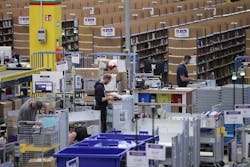GM Puts an End to the Safety Metrics Game
To help foster a culture truly devoted to safety, General Motors has shifted its focus from corporate safety metrics to 'sentinel events' that help eliminate risks before accidents happen.
But that's not how it works at GM.
In his presentation at EHS Today's Safety Leadership Conference, GM's Senior Manager for health and Safety, Mike Douglas, explained that GM's road to safety begins by throwing out the metrics.
"When you have folks trying to get their numbers down, it quells reporting," he said. "People play with the numbers to get them into range."
That, he said, defeats the whole point of safety. It's not about meeting some corporate goals; it's about getting your people home safe. Requiring a certain drop in metrics does nothing to alter the real state of safety.
So GM changed its reporting objectives.
"We got away from this idea of tracking numbers," Douglas explained. "We don't care about that. We want to know everything."
So, rather than the usual metrics, the company has turned to sentinel events—any and every situation anywhere across its production or supply chains that could have killed someone, caused a life-altering injury or resulted in hospitalization. Even if no one was ever harmed.
As Douglas explains, it's a system of measuring "...how many folks by sheer luck or variables out of their control escaped an event that could have resulted in a fatality."
Basically, he said, this means tapping into the water cooler talk about what really happens day to day in the plants—about all of the close calls and could'ves that workers deal with in their jobs. Falling chains, rusted fixtures, that time someone on the line almost got nailed.
"In your place of work, there are [potentially dangerous] things happening every day," he says. "We had to learn to listen to what is really going on."
The results of this shift are rather remarkable.
According to Douglas, in the year it lost three workers on GM premises, it recorded over 4,000 sentinel events—48 of which could have resulted in a fatality if luck had fallen the other way.
This means, that rather than being left with three serious hazards to investigate and resolve at the end of the year, the company has thousands. It means that, once they have been corrected, the company will show certifiable and significant real-life improvements to the safety and security of its workers.
It's not a corporate game. It's not meeting quotas and fudging numbers. It's real improvements to real hazards, eliminating risk before an event ever occurs.
About the Author
Travis Hessman
VP of Content, Endeavor Business Media
Travis Hessman is the VP of Content for Endeavor Business Media. Previously, Travis was the Editor-in-Chief for Industry Week and New Equipment Digest as well as the Group Editorial Director for Endeavor's Manufacturing Group.
He began his career as an intern at IndustryWeek in 2001 and later served as IW's technology and innovation editor. Today, he combines his experience as an educator, a writer, and a journalist to help address some of the most significant challenges in the manufacturing industry, with a particular focus on leadership, training, and the technologies of smart manufacturing.

